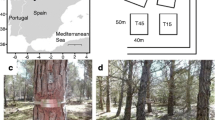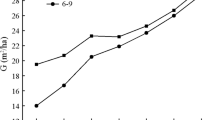Abstract
This paper summarises the results from 35 years-observed thinning experiments on 256 permanent sample plots in 10–60 year-old stands of ash, aspen, birch, oak, pine and spruce in Lithuania. Thinning enhanced crown projection area increment of residual trees. The largest effect was observed in stands of aspen and birch (growth increase by 200%), followed by ash and oak (over 100%), and spruce and pine (about 80%). Thinning also promoted dbh increment, especially in younger stands, and the increase of dbh increment was positively correlated with the thinning intensity. The strongest reaction was exhibited by oak and aspen, while ash, birch and conifers reacted to a lower extent. Low and moderate intensities of thinning stimulated volume production in younger stands while the opposite was observed in older stands with increasing removals. Spruce stands exhibited relatively strongest increase of volume increment and pine, –the weakest, while the effect on deciduous species was intermediate. The results demonstrate that significant increase in volume increment is achievable with thinning of only young forest stands, e.g. 10–20 year-old pine, birch and ash, or 10–30 year-old oak, aspen and spruce.




Similar content being viewed by others
References
Andersson SO (1980) Volume increment and stand safety in different types of thinning. Schr Forstl Fak Univ Gttingen 67:260–268
Antanaitis VV, Zagreyev VV (1969) Increment of forest stands (in Russian). Lesnaya Promyshlennost, Moscow
Assmann E (1950) Grundflächen- und Volumenzuwachs der Rotbuche bei verschiedenen Durchforstungsgraden. Forstwiss Centralbl 69:256–286
Assmann E (1954) Grundflächenhaltung und Zuwachsleistung Bayrischer Fichten- Durchforstungsreihen. Forstwiss Centralbl 73:257–271
Assmann E (1961) Waldertragskunde. BLV Verlagsgesellschaft, Munchen, Bonn, Wien
Baldwin VCJr, Peterson KD, Clark IIIA, Ferguson RB, Strub MR, Bower DR (2000) The effects of spacing and thinning on stand and tree characteristics of 38-year-old lobolly pine. Forest Ecol Manage 137:91–102
Brukas A (1994) Die Wälder und Bestände. In: Deltuva R (ed). Wälder und Nationalparks in Litauen. Enciklopedija, Vilnius, pp 16–29
Butenas J, Repsys J (1983) Growth and yield tables of pine and spruce stands (in Lithuanian). In: Repsys J, Kenstavicius J, Kuliesis A (eds). Handbook of forest mensuration. Mokslas, Vilnius, pp 84–90
Buzykin AI, Pshenichnikova LS (1980) Thinnings in mixed pine-deciduous stands (in Russian). Nauka, Novosibirsk
Canellas I, Del Rio M, Roig S, Montero G (2004) Growth response to thinning in Quercus pyrenaica Willd. coppice stands in Spanish central mountain. Ann Forest Sci 61:243–250
Daume S, Robertson D (2000) A heuristic approach to modelling thinning. Silva Fenn 34:237–249
Georgievsky NP (1957) Thinning of forest stands (in Russian). Goslesbumizdat, Moscow-Leningrad
Guericke M (2002) Untersuchungen zur Wuchsdynamik der Buche. Forst und Holz 57:331–337
Houtzagers MR (2002) Thinning in discussion (in Dutch). Nederlands Bosbouwtijdschr 74:7–14
Hamilton GJ (1976) The Bowmont Norway spruce thinning experiment 1930–1974. Forestry (Oxford) 49:109–121
Hamilton GJ (1981) The effects of high intensity thinning on yield. Forestry (Oxford) 54:1–15
Eriksson H, Karlsson K (1997) Effects of different thinning and fertilization regimes on the development of Scots pine (Pinus sylvestris (L.)) and Norway spruce (Picea abies (L.) Karst.) stands in long-term silvicultural trials in Sweden (in Swedish, English summary). Report 42, Swedish University of Agricultural Sciences, Department of Forest Yield Research, Uppsala
Eule H-W (1959) Verfahren zur Baumkronenmessung und Beziehungen zwischen Kronengrsse, Stammstrke und Zuwachs der Rotbuche, dargestellt an einer nordwestdeutschen Durchforstungsversuchsreihe. Allg Forst- u Jagd- Ztg 130:185–201
Juodvalkis A (1981) Silvicultural and biological fundamentals, and thinning programs for industrial forests of southern Baltic (in Russian). DSc Thesis, VN Sukachev Forest and Wood Science Institute of the Academy of Sciences of the USSR, Krasnoyarsk
Juodvalkis A et al. (2000) Regulations for thinning and sanitary felling (in Lithuanian). Naujasis Lankas, Kaunas
Kairiukstis L, Juodvalkis A (1985) Thinnings and maximal yield of forest stands (in Lithuanian). Mokslas, Vilnius
Kairiukstis L et al. (1974) Thinning regulations in forests of Lithuania (in Lithuanian). Ministry of Forestry, Vilnius
Kairiukstis L et al. (1983a) Growth models of maximally productive forest stands (in Lithuanian). In: Repsys J, Kenstavicius J, Kuliesis A (eds). Handbook of forest mensuration. Mokslas, Vilnius, pp 97–103
Kairiukstis L et al. (1983b) Programs for thinning of maximally productive forest stands (in Lithuanian). In: Repsys J, Kenstavicius J, Kuliesis A (eds). Handbook of forest mensuration. Mokslas, Vilnius, pp 223–226
Karazija S (1988) Forest types of Lithuania (in Lithuanian). Mokslas, Vilnius
Kennel R (1966) Soziale Stellung, Nachbarschaft und Zuwachs. Forstwiss Centralbl 85:193–204
Kuliesis A et al. (1983) Volume of forest stands in relation to dbh and height (in Lithuanian). In: Repsys J, Kenstavicius J, Kuliesis A (eds). Handbook of forest mensuration. Mokslas, Vilnius, pp 36–53
Lockow KW (2003) The effect of thinning regimes on the dynamics of Scots pine stand development (in Polish, English summary). Sylwan 9:3–9
Makinen H, Isomaki A (2004a) Thinning intensity and growth of Norway spruce stands in Finland. Forestry (Oxford) 77:349–364
Makinen H, Isomaki A (2004b) Thinning intensity and growth of Scots pine stands in Finland. Forest Ecol Manage 201:311–325
Moller CM (1947) The effect of thinning, age, and site on foliage, increment, and loss of dry matter. J Forestry 45:393–404
Nowak CA (1996) Wood volume increment in thinned, 50- to 55-year-old, mixed species Allegheny hardwoods. Can J Forest Res 26:819–835
Oyen BH (2003) Thinning of spruce in Sorlandet –effects on growth, size and gain (in Norwegian). Rapp fra Skogforsk 2/03:1–16
Pretzsch H (1992) Modellierung der Kronenkonkurrenz von Fichte und Buche in Rein- und Mischbeständen. Allg Forst- u Jagd- Ztg 163:203–213
Repsys J, Antanaitis V (1970) Forest mensuration (in Lithuanian). Mintis, Vilnius
Stefancik I, Stefancik L (2001) Assessment of tending effect on stand structure and stability in mixed stands of spruce, fir and beech on research plot Hrable. J Forest Sci (Zvolen) 47:1–14
Stefancik I, Stefancik L (2002) Assessment of long-term tending in mixed stands of spruce, fir and beech on research plot Korytnica. J Forest Sci (Zvolen) 48:100–114
Toma ST (1940) Kronenuntersuchungen in langfristigen Kieferndurchforstungsflächen. Zeitschr f Forst- u Jagdw 72:305–340, 379–404
Tullus H (2002) The influence of intermediate cuttings on the growth of pine and spruce forests: silvicultural recommendations. Metsanduslikud Uurimused (Forestry Studies, Tartu) 36:126–135
Varmola M, Salminen H (2004) Timing and intensity of precommercial thinning in Pinus sylvestris stands. Scand J Forest Res 19:142–151
Vasiliauskas R (1998) Damages to stands of spruce associated with commercial thinning (in Lithuanian, English summary). Miskininkyste (Forestry Science, Kaunas) 41:47–57
Vasiliauskas R (2001) Damage to trees due to forestry operations and its pathological significance in temperate forests. A literature review. Forestry (Oxford) 74:319–336
Wohlfahrt E (1935) Auswirkungen langjhriger Kronenpflege in mitteldeutschen Fichtenbestnden. Zeitschr f Forst- u Jagdw 67:289–310, 344–360
Zeide B (2001) Thinning and growth: a full turnaround. J Forestry 99:20–25
Zeide B (2004) Optimal stand density: a solution. Can J Forest Res 34:846–854
Author information
Authors and Affiliations
Corresponding author
Additional information
Communicated by Hans Pretzsch
Rights and permissions
About this article
Cite this article
Juodvalkis, A., Kairiukstis, L. & Vasiliauskas, R. Effects of thinning on growth of six tree species in north-temperate forests of Lithuania. Eur J Forest Res 124, 187–192 (2005). https://doi.org/10.1007/s10342-005-0070-x
Received:
Accepted:
Published:
Issue Date:
DOI: https://doi.org/10.1007/s10342-005-0070-x




